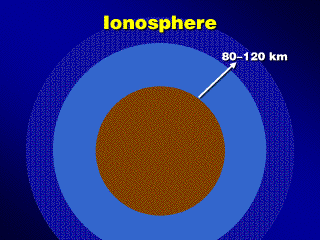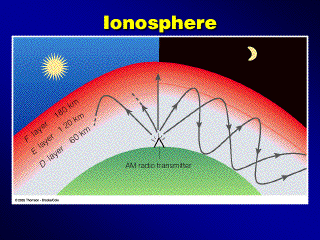 An ion is an atom or molecule that has lost or gained an electron, compared
to its neutral state. The ionosphere in the thermosphere
contains a lot of ions, which were produced when the atoms/molecules absorbed
high-energy sunlight. These ions are "charged" or "excited",
and when they react with each other or some other substance, the excess energy
absorbed earlier is released in the form of light.
An ion is an atom or molecule that has lost or gained an electron, compared
to its neutral state. The ionosphere in the thermosphere
contains a lot of ions, which were produced when the atoms/molecules absorbed
high-energy sunlight. These ions are "charged" or "excited",
and when they react with each other or some other substance, the excess energy
absorbed earlier is released in the form of light.
At night, the ionosphere tends to
reflect radio waves originating from the Earth's surface. This increases the
broadcasting range of strong AM radio stations.
When the sun is unusually "active",
the solar wind emitted from it carries a large number of ions from the
sun. These particles are captured by the Earth's magnetic field lines of force.
This lines all go to either magnetic pole, thus concentrating these solar wind
ions over the polar regions. The solar wind particles then react with the ions
in the ionosphere, which produces photons of visible light; the concentration
of the reactions there can produce enough light in one place to be visible to
the naked eye as the aurora borealis.
 After sunset, the D-region layer disappears. During the daytime, this ionospheric
layer scatters AM radio waves, so radio stations cannot transmit to locations
that are not line-of-sight from the transmitting antenna. The E- and F-regions
can reflect the radio waves more directly instead of scattering them, so at
night, AM radio stations can sometimes be heard thousands of miles away. In
the "Sunrise Effect", one loses the signals from the distant radio
stations at the moment the Sun rises over the horizon, which is when the D-region
re-forms.
After sunset, the D-region layer disappears. During the daytime, this ionospheric
layer scatters AM radio waves, so radio stations cannot transmit to locations
that are not line-of-sight from the transmitting antenna. The E- and F-regions
can reflect the radio waves more directly instead of scattering them, so at
night, AM radio stations can sometimes be heard thousands of miles away. In
the "Sunrise Effect", one loses the signals from the distant radio
stations at the moment the Sun rises over the horizon, which is when the D-region
re-forms.


 An ion is an atom or molecule that has lost or gained an electron, compared
to its neutral state. The ionosphere in the thermosphere
contains a lot of ions, which were produced when the atoms/molecules absorbed
high-energy sunlight. These ions are "charged" or "excited",
and when they react with each other or some other substance, the excess energy
absorbed earlier is released in the form of light.
An ion is an atom or molecule that has lost or gained an electron, compared
to its neutral state. The ionosphere in the thermosphere
contains a lot of ions, which were produced when the atoms/molecules absorbed
high-energy sunlight. These ions are "charged" or "excited",
and when they react with each other or some other substance, the excess energy
absorbed earlier is released in the form of light. After sunset, the D-region layer disappears. During the daytime, this ionospheric
layer scatters AM radio waves, so radio stations cannot transmit to locations
that are not line-of-sight from the transmitting antenna. The E- and F-regions
can reflect the radio waves more directly instead of scattering them, so at
night, AM radio stations can sometimes be heard thousands of miles away. In
the "Sunrise Effect", one loses the signals from the distant radio
stations at the moment the Sun rises over the horizon, which is when the D-region
re-forms.
After sunset, the D-region layer disappears. During the daytime, this ionospheric
layer scatters AM radio waves, so radio stations cannot transmit to locations
that are not line-of-sight from the transmitting antenna. The E- and F-regions
can reflect the radio waves more directly instead of scattering them, so at
night, AM radio stations can sometimes be heard thousands of miles away. In
the "Sunrise Effect", one loses the signals from the distant radio
stations at the moment the Sun rises over the horizon, which is when the D-region
re-forms.